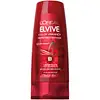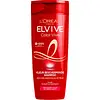What's inside
What's inside
 Key Ingredients
Key Ingredients

 Benefits
Benefits

 Concerns
Concerns

 Ingredients Side-by-side
Ingredients Side-by-side

Water
Skin ConditioningCetearyl Alcohol
EmollientBehentrimonium Chloride
PreservativeGlycerin
HumectantCetyl Esters
EmollientParfum
MaskingIsopropyl Myristate
EmollientIsopropyl Alcohol
SolventPhenoxyethanol
PreservativeLauryl PEG/PPG-18/18 Methicone
Skin ConditioningPoly(Linseed Oil)
Ethylhexyl Methoxycinnamate
UV AbsorberArginine
MaskingGlutamic Acid
HumectantLinalool
PerfumingHexyl Cinnamal
PerfumingNiacinamide
SmoothingTocopherol
AntioxidantChlorhexidine Digluconate
AntimicrobialCitric Acid
BufferingBenzophenone-4
UV AbsorberBenzyl Salicylate
PerfumingSerine
MaskingBenzyl Alcohol
PerfumingHydroxypropyltrimonium Hydrolyzed Wheat Protein
Skin ConditioningLimonene
PerfumingDodecene
MaskingPoloxamer 407
EmulsifyingAmyl Cinnamal
PerfumingCitronellol
PerfumingDisodium EDTA
Alpha-Isomethyl Ionone
PerfumingWater, Cetearyl Alcohol, Behentrimonium Chloride, Glycerin, Cetyl Esters, Parfum, Isopropyl Myristate, Isopropyl Alcohol, Phenoxyethanol, Lauryl PEG/PPG-18/18 Methicone, Poly(Linseed Oil), Ethylhexyl Methoxycinnamate, Arginine, Glutamic Acid, Linalool, Hexyl Cinnamal, Niacinamide, Tocopherol, Chlorhexidine Digluconate, Citric Acid, Benzophenone-4, Benzyl Salicylate, Serine, Benzyl Alcohol, Hydroxypropyltrimonium Hydrolyzed Wheat Protein, Limonene, Dodecene, Poloxamer 407, Amyl Cinnamal, Citronellol, Disodium EDTA, Alpha-Isomethyl Ionone
Water
Skin ConditioningSodium Laureth Sulfate
CleansingDimethicone
EmollientCoco-Betaine
CleansingSodium Chloride
MaskingGlycol Distearate
EmollientGuar Hydroxypropyltrimonium Chloride
Skin ConditioningCocamide Mipa
EmulsifyingCocos Nucifera Oil
MaskingSodium Benzoate
MaskingSodium Hydroxide
BufferingPaeonia Officinalis Flower Extract
TonicEthylhexyl Salicylate
UV AbsorberSalicylic Acid
MaskingFumaric Acid
BufferingBenzyl Alcohol
PerfumingBenzyl Salicylate
PerfumingLinalool
PerfumingAlpha-Isomethyl Ionone
PerfumingCarbomer
Emulsion StabilisingGeraniol
PerfumingCitric Acid
BufferingCitronellol
PerfumingPotassium Sorbate
PreservativeHexylene Glycol
EmulsifyingHexyl Cinnamal
PerfumingGlycerin
HumectantParfum
MaskingWater, Sodium Laureth Sulfate, Dimethicone, Coco-Betaine, Sodium Chloride, Glycol Distearate, Guar Hydroxypropyltrimonium Chloride, Cocamide Mipa, Cocos Nucifera Oil, Sodium Benzoate, Sodium Hydroxide, Paeonia Officinalis Flower Extract, Ethylhexyl Salicylate, Salicylic Acid, Fumaric Acid, Benzyl Alcohol, Benzyl Salicylate, Linalool, Alpha-Isomethyl Ionone, Carbomer, Geraniol, Citric Acid, Citronellol, Potassium Sorbate, Hexylene Glycol, Hexyl Cinnamal, Glycerin, Parfum
Ingredients Explained
These ingredients are found in both products.
Ingredients higher up in an ingredient list are typically present in a larger amount.
Alpha-Isomethyl Ionone is a fragrance. It can be synthetically created or naturally occurring.
The scent of Alpha-Isomethyl Ionone is described as "flowery" but can also be "woody".
Naturally occurring Alpha-Isomethyl Ionone may be found in Saccharomyces cerevisiae, or the yeast used to make wine and bread.
The term 'fragrance' is not regulated in many countries. In many cases, it is up to the brand to define this term. For instance, many brands choose to label themselves as "fragrance-free" because they are not using synthetic fragrances. However, their products may still contain ingredients such as essential oils that are considered a fragrance.
Learn more about Alpha-Isomethyl IononeBenzyl Alcohol is most commonly used as a preservative. It also has a subtle, sweet smell. Small amounts of Benzyl Alcohol is not irritating and safe to use in skincare products. Most Benzyl Alcohol is derived from fruits such as apricots.
Benzyl Alcohol has both antibacterial and antioxidant properties. These properties help lengthen the shelf life of products. Benzyl Alcohol is a solvent and helps dissolve other ingredients. It can also improve the texture and spreadability.
Alcohol comes in many different forms. Different types of alcohol will have different effects on skin. This ingredient is an astringent alcohol.
Using high concentrations of these alcohols are drying on the skin. They may strip away your skin's natural oils and even damage your skin barrier. Astringent alcohols may also irritate skin.
Other types of astringent alcohols include:
According to the National Rosacea Society based in the US, you should be mindful of products with these alcohols in the top half of ingredients.
Any type of sanitizing product will have high amounts of alcohol to help kill bacteria and viruses.
Learn more about Benzyl AlcoholBenzyl Salicylate is a solvent and fragrance additive. It is an ester of benzyl alcohol and salicylic acid. This ingredient can be naturally found in some plants and plant extracts.
In fragrances, Benzyl Salicylate may be a solvent or a fragrance component. In synthetic musk scents, it is used as a solvent. For floral fragrances such as lilac and jasmine, it is used as a fragrance component. The natural scent of Benzyl Salicylate is described as "lightly-sweet, slightly balsamic".
While Benzyl Salicylate has been associated with contact dermatitis and allergies, emerging studies show it may not be caused by this ingredient alone.
However, this ingredient is often used with fragrances and other components that may cause allergies. It is still listed as a known allergen in the EU. We recommend speaking with a professional if you have concerns.
Another study from 2021 shows Benzyl Salicylate may have anti-inflammatory properties.
Learn more about Benzyl SalicylateCitric Acid is an alpha hydroxy acid (AHA) naturally found in citrus fruits like oranges, lemons, and limes.
Like other AHAs, citric acid can exfoliate skin by breaking down the bonds that hold dead skin cells together. This helps reveal smoother and brighter skin underneath.
However, this exfoliating effect only happens at high concentrations (20%) which can be hard to find in cosmetic products.
Due to this, citric acid is usually included in small amounts as a pH adjuster. This helps keep products slightly more acidic and compatible with skin's natural pH.
In skincare formulas, citric acid can:
While it can provide some skin benefits, research shows lactic acid and glycolic acid are generally more effective and less irritating exfoliants.
Most citric acid used in skincare today is made by fermenting sugars (usually from molasses). This synthetic version is identical to the natural citrus form but easier to stabilize and use in formulations.
Read more about some other popular AHA's here:
Learn more about Citric AcidCitronellol is used to add fragrance/parfum to a product. It is often derived from plants such as roses. In fact, it can be found in many essential oils including geranium, lavender, neroli, and more. The scent of Citronellol is often described as "fresh, grassy, and citrus-like".
Since the Citronellol molecule is already unstable, Citronellol becomes irritating on the skin when exposed to air.
Citronellol is a modified terpene. Terpenes are unsaturated hydrocarbons found in plants. They make up the primary part of essential oils.
Citronellol is not able to be absorbed into deeper layers of the skin. It has low permeability,
Citronellol is also a natural insect repellent.
Learn more about CitronellolGlycerin is already naturally found in your skin. It helps moisturize and protect your skin.
A study from 2016 found glycerin to be more effective as a humectant than AHAs and hyaluronic acid.
As a humectant, it helps the skin stay hydrated by pulling moisture to your skin. The low molecular weight of glycerin allows it to pull moisture into the deeper layers of your skin.
Hydrated skin improves your skin barrier; Your skin barrier helps protect against irritants and bacteria.
Glycerin has also been found to have antimicrobial and antiviral properties. Due to these properties, glycerin is often used in wound and burn treatments.
In cosmetics, glycerin is usually derived from plants such as soybean or palm. However, it can also be sourced from animals, such as tallow or animal fat.
This ingredient is organic, colorless, odorless, and non-toxic.
Glycerin is the name for this ingredient in American English. British English uses Glycerol/Glycerine.
Learn more about GlycerinHexyl Cinnamal is a fragrance ingredient with a similar scent to jasmine. It can be naturally found in chamomile essential oil.
This ingredient is a known EU allergen and may sensitize the skin. The EU requires this ingredient to be listed separately on an ingredients list.
Hexyl Cinnamal is not water soluble but is soluble in oils.
Learn more about Hexyl CinnamalLinalool is a fragrance and helps add scent to products. It's derived from common plants such as cinnamon, mint, citrus, and lavender.
Like Limonene, this ingredient oxidizes when exposed to air. Oxidized linalool can cause allergies and skin sensitivity.
This ingredient has a scent that is floral, spicy tropical, and citrus-like.
Learn more about LinaloolParfum is a catch-all term for an ingredient or more that is used to give a scent to products.
Also called "fragrance", this ingredient can be a blend of hundreds of chemicals or plant oils. This means every product with "fragrance" or "parfum" in the ingredients list is a different mixture.
For instance, Habanolide is a proprietary trade name for a specific aroma chemical. When used as a fragrance ingredient in cosmetics, most aroma chemicals fall under the broad labeling category of “FRAGRANCE” or “PARFUM” according to EU and US regulations.
The term 'parfum' or 'fragrance' is not regulated in many countries. In many cases, it is up to the brand to define this term.
For instance, many brands choose to label themselves as "fragrance-free" because they are not using synthetic fragrances. However, their products may still contain ingredients such as essential oils that are considered a fragrance by INCI standards.
One example is Calendula flower extract. Calendula is an essential oil that still imparts a scent or 'fragrance'.
Depending on the blend, the ingredients in the mixture can cause allergies and sensitivities on the skin. Some ingredients that are known EU allergens include linalool and citronellol.
Parfum can also be used to mask or cover an unpleasant scent.
The bottom line is: not all fragrances/parfum/ingredients are created equally. If you are worried about fragrances, we recommend taking a closer look at an ingredient. And of course, we always recommend speaking with a professional.
Learn more about ParfumWater. It's the most common cosmetic ingredient of all. You'll usually see it at the top of ingredient lists, meaning that it makes up the largest part of the product.
So why is it so popular? Water most often acts as a solvent - this means that it helps dissolve other ingredients into the formulation.
You'll also recognize water as that liquid we all need to stay alive. If you see this, drink a glass of water. Stay hydrated!
Learn more about Water